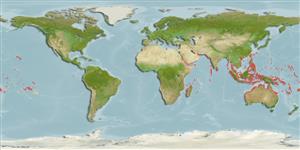Common names from other countries
>
Ovalentaria/misc (Various families in series Ovalentaria) >
Pomacentridae (Damselfishes) > Glyphisodontinae
Etymology: Abudefduf: Arabic, abu = father; this fish is the leader of the reef against other species (Ref. 45335).
More on author: Forsskål.
Environment: milieu / Klimaatzone / Diepte / distribution range
Ecologie
marien; brak water rifbewoner; standvastig; diepte 0 - 3 m (Ref. 4391). Tropical; 27°N - 37°S, 49°W - 126°W (Ref. 56028)
Indo-Pacific: Red Sea and East Africa to the Hawaiian and Pitcairn islands, north to Japan, south to Australia.
Grootte / Gewicht / Leeftijd
Maturiteit: Lm ? range ? - ? cm
Max length : 24.0 cm TL mannelijk / geslacht onbekend; (Ref. 90102)
Korte beschrijving
Determinatiesleutels | Morfologie | Morfometrie
Dorsale stekels (totaal) : 13; Dorsale zachte stralen (totaal) : 14 - 16; Anale stekels: 2; Anale zachte stralen: 14 - 15.
Body shape (shape guide): short and / or deep; Cross section: compressed.
Inhabit rocky lagoons, reef flat shorelines and piers subject to mild surge; juveniles are common in tide pools (Ref. 9710). Benthopelagic (Ref. 58302). Occasionally form schools. Feed on algae, crustaceans and other invertebrates during the day. Oviparous, distinct pairing during breeding (Ref. 205). Eggs are demersal and adhere to the substrate (Ref. 205). Males guard and aerate the eggs (Ref. 205). Highly territorial (Ref. 9710). Utilized as a food fish by the Hawaiians (Ref. 7364).
Levenscyclus en paargedrag
Maturiteit | Voortplanting | Paaien | Eieren | Fecunditeit | Larven
Oviparous, distinct pairing during breeding (Ref. 205). Eggs are demersal and adhere to the substrate (Ref. 205). Males guard and aerate the eggs (Ref. 205).
Allen, G.R., 1991. Damselfishes of the world. Mergus Publishers, Melle, Germany. 271 p. (Ref. 7247)
Status op de Rode Lijst van het IUCN (Ref. 130435: Version 2025-1)
Gevaar voor de mens
Harmless
Gebruik door de mens
Visserij: van minder commercieel belang; Aquarium: Commercieel
Tools
Speciale rapporten
Download XML
Internetbronnen
Estimates based on models
Preferred temperature (Ref.
123201): 24.7 - 29.3, mean 28.4 °C (based on 2750 cells).
Fylogenetische diversiteitsindex (Ref.
82804): PD
50 = 0.5000 [Uniqueness, from 0.5 = low to 2.0 = high].
Bayesian length-weight: a=0.02455 (0.01335 - 0.04514), b=3.11 (2.95 - 3.27), in cm total length, based on LWR estimates for this species & Genus-body shape (Ref.
93245).
Trofisch niveau (Ref.
69278): 2.9 ±0.0 se; based on diet studies.
Weerstandsvermogen (Ref.
120179): Gemiddeld, minimale populatieverdubbelingstijd 1,4-4,4 jaar (Preliminary K or Fecundity.).
Fishing Vulnerability (Ref.
59153): Low vulnerability (14 of 100).
🛈
Nutrients (Ref.
124155): Calcium = 71.2 [35.8, 112.8] mg/100g; Iron = 0.593 [0.351, 1.034] mg/100g; Protein = 18.8 [17.6, 19.9] %; Omega3 = 0.0879 [, ] g/100g; Selenium = 16.2 [8.3, 31.9] μg/100g; VitaminA = 69.8 [19.2, 240.5] μg/100g; Zinc = 1.69 [1.12, 2.56] mg/100g (wet weight);
